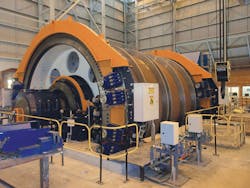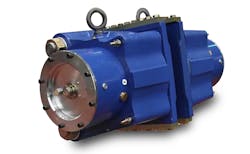Precise Brakes Hold Heavy Loads in African Copper Mine
Just about every heavy industry uses hoists, and the mining industry uses some of the largest and most powerful. With four underground mines and an open-pit mine, Mopani Copper’s Nkana Mine in Zambia is among the largest copper and cobalt mines in all of Africa.
Leading mine-hoist manufacturer FLSmidth, which provides a wide variety of products and services to the mining industry, designed and manufactured large hoists for the Nkana Mine. Working in conjunction with Twiflex Ltd. and its South African distributor, Tritec Sintered Products, FLSmidth supplied a double-drum Blair Multi-Rope (BMR) rock winder and a single-drum BMR man/materials winder to the Nkana project. The BMR winder is a variation of a double-drum winder for use in extremely deep shafts where the second drum’s cable help balance the primary load. The drums on both winders are identical; each has a diameter of 5.7 m and two 1.8-m wide rope compartments.
The double-drum BMR has a payload of metric 47.5 tons and operates at speeds up to 17.6 m/sec (59 rpm) in a 1,278-m-deep shaft. FLSmidth designed a precise control system to achieve synchronous braking of all brake units. Twiflex brakes are spring-applied and hydraulically released for parking and holding the winders whenever they stop. In the rare event of a power failure or other emergency, the brakes can bring the load to a halt while maintaining a maximum deceleration of 2.3 m/sec2.
To meet the hoists’ high rubbing speeds and provide high thermal capacity, Twiflex engineers designed a new large-pad version (174,700 mm2 each pad) of its popular VMS3-SPS spring-applied, hydraulically released brake, which is widely used on mine hoists around the world. Sixteen of the brakes (eight on the fixed drum and eight on the clutched drum) operate on two 6,800-mm diameter, 70-mm thick discs, producing a total braking torque of 12.2 MN-m. Each brake is rated to 240 kN braking force (µ=0.4) using a 2mm air gap for this application. At this braking force, the rated fatigue life exceeds 2 million braking cycles.
To assist with maintenance, Twiflex brakes incorporate a monitoring system to signal brake-pad wear and loss of braking force. The VMS3-VR brakes also include Twiflex’s “parked off” feature, meaning they can be adjusted under hydraulic pressure to release any stored energy when pressure is relieved. Twiflex has an in-house testing capability, comprising a climatic chamber that can simulate temperatures between –75 to +180°C. It also has a fatigue room for brake cycling and an inertia test rig for dynamic stops.
This information was provided by Jonathan Cooksley, sales and marketing director at Twiflex Ltd., part of Altra Industrial Motion. For more information, call Twiflex in the U.S. at (844) 723-3483, or visit the company's website.
About the Author
Jonathan Cooksley
Sales and Marketing Director

Leaders relevant to this article:


